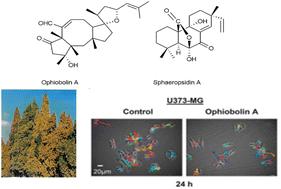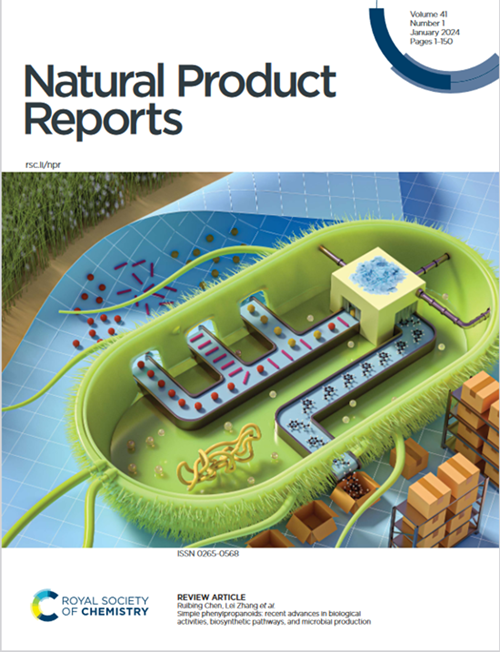ophiobolin A 和 sphaeropsidin A 的神奇故事:两种真菌萜类化合物从诱发枯萎的植物毒素到前景广阔的抗癌化合物。
摘要
本综述介绍了ophiobolin A(OphA)和sphaeropsidin A(SphA)的非凡故事,它们分别是一种酯萜和一种二萜,最初作为真菌植物毒素被分离出来,随后被证明具有其他有趣的生物活性,包括有希望的抗癌活性。Ophiobolin A 是一种由不同真菌病原体产生的植物毒素,这些病原体都属于双孢蘑菇属。最初,人们只知道它是由侵袭大米和大麦等重要谷物的真菌产生的一种非常危险的植物毒素。然而,为了确定它的原始碳骨架,人们进行了大量有趣的研究,其特点是典型的 5 : 8 :5 环系统的特点,以及它对寄主植物和非寄主植物的植物毒性活性。通过描述从甲羟戊酸开始的不同步骤,以及通过无环 C-25 前体的重排获得毒素的过程,还对 OphA 的生物合成进行了定义。OphA 还作为一种生物除草剂从 Drechslera gigantea 中生产出来,并建议用于对广泛分布的危险杂草 Digitaria sanguinaria 进行生物防治。迄今为止,已从不同真菌中分离出六十多种ophiobolins,并对其生物活性和结构-活性关系进行了研究,还利用其半合成衍生物对其进行了描述。近二十年来,人们对 OphA 的潜在抗癌活性及其原始作用模式进行了深入研究,引起了科学家们的极大兴趣。Sphaeropsidin A 也有类似的故事。它是从意大利柏树腐烂病的病原体 Diplodia cupressi 中分离出来的主要植物毒素,导致地中海盆地在几年内损失了数百万株植物。对森林、环境和观赏遗产造成的破坏值得注意,苗圃和木材工业也蒙受了经济损失。为了研究 SphA 的结构-活性关系,我们分离了六种 SphA 天然类似物,并制备了几种有趣的半合成衍生物。令人惊讶的是,Sphaeropsidin A 还具有其他有趣的生物活性,包括抗生素、抗真菌和抗病毒。近十年来,人们对 SphA 的抗癌活性和原始作用模式进行了广泛的研究。此外,通过特定的半合成研究,可以制备出 SphA 的衍生物,但保留了其发色团,从而显著提高了抗癌活性。研究表明,ophiobolin A 和 sphaeropsidin A 是很有前途的天然产品,对一些恶性癌症,如脑胶质母细胞瘤和不同的黑色素瘤有很强的抗癌活性。


Covering: 2000 to 2023
This review presents the exceptional story of ophiobolin A (OphA) and sphaeropsidin A (SphA), a sesterterpene and a diterpene, respectively, which were initially isolated as fungal phytotoxins and subsequently shown to possess other interesting biological activities, including promising anticancer activities. Ophiobolin A is a phytotoxin produced by different fungal pathogens, all belonging to the Bipolaris genus. Initially, it was only known as a very dangerous phytotoxin produced by fungi attacking essential cereals, such as rice and barley. However, extensive and interesting studies were carried out to define its original carbon skeleton, which is characterized by a typical 5 : 8 : 5 ring system and shared with fusicoccins and cotylenins, and its phytotoxic activity on host and non-host plants. The biosynthesis of OphA was also defined by describing the different steps starting from mevalonate and through the rearrangement of the acyclic C-25 precursor lead the toxin is obtained. OphA was also produced as a bioherbicide from Drechslera gigantea and proposed for the biocontrol of the widespread and dangerous weed Digitaria sanguinaria. To date, more than sixty ophiobolins have been isolated from different fungi and their biological activities and structure–activity relationship investigated, which were also described using their hemisynthetic derivatives. In the last two decades, thorough studies have been performed on the potential anticancer activity of OphA and its original mode of action, attracting great interest from scientists. Sphaeropsidin A has a similar story. It was isolated as the main phytotoxin from Diplodia cupressi, the causal agent of Italian cypress canker disease, resulting in the loss of millions of plants in a few years in the Mediterranean basin. The damage to the forest, environment and ornamental heritage are noteworthy and economic losses are also suffered by tree nurseries and the wood industry. Six natural analogues of SphA were isolated and several interesting hemisynthetic derivatives were prepared to study its structure–activity relationship. Surprisingly, sphaeropsidin A showed other interesting biological activities, including antibiotic, antifungal, and antiviral. In the last decade, extensive studies have focused on the anticancer activity and original mode of action of SphA. Furthermore, specific hemisynthetic studies enable the preparation of derivatives of SphA, preserving its chromophore, which showed a noteworthy increase in anticancer activity. It has been demonstrated that ophiobolin A and sphaeropsidin A are promising natural products showing potent activity against some malignant cancers, such as brain glioblastoma and different melanomas.

 求助内容:
求助内容: 应助结果提醒方式:
应助结果提醒方式:


